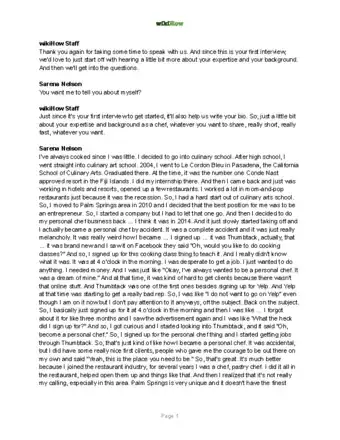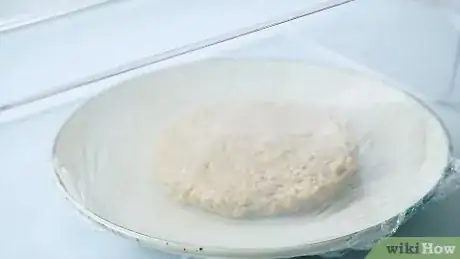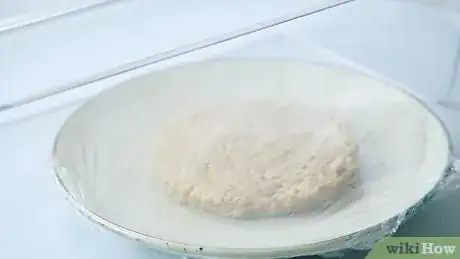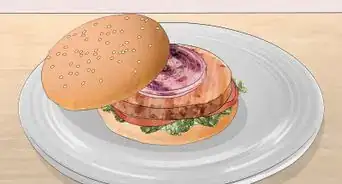This article was co-authored by Sarena Nelson and by wikiHow staff writer, Dev Murphy. Sarena Nelson is a Private Chef and the Founder of Chef Sarena, based in Palm Springs, California. With over 10 years of experience, she specializes in customized menus for private events, has worked in 5-star restaurants, and has helped small restaurants redesign their menus. She earned her degree from Le Cordon Bleu School of Culinary Arts in Pasadena, California.
There are 13 references cited in this article, which can be found at the bottom of the page.
This article has been viewed 1,413 times.
Plant-based meat alternatives have been gaining in popularity in recent years—and no wonder when they’re so delicious, healthy, and good for the planet. One of the most popular meat alternatives is plant-based burgers. They can taste just like the real thing, but they’re prepared a bit differently. Whether you make your own plant-based burgers or buy them from the store, we’ve assembled the best methods for cooking the plant-based burger of your dreams.
Things You Should Know
- Cook plant-based burgers in a skillet for 2 to 4 minutes on each side.
- On a grill, cook each side of the patty for 8 to 10 minutes.
- Bake plant-based burgers in the oven at 400 °F (204 °C) for 12 to 15 minutes, flipping halfway through.
- Heat plant-based patties to 135 °F (57 °C), regardless of the cooking method, and season your burgers after cooking for the best taste and texture.
Steps
Cooking Plant-Based Burgers in a Skillet
-
1Preheat and oil your skillet. A skillet or any kind of flat pan is usually the best way to cook a plant-based burger, since they aren't usually super compact and might fall apart. Completely coat the skillet in vegetable oil, and heat until the oil is so hot that it looks wavy. You want the pan to be blistering-hot before you place your patties on it.[1]
- You can also try canola, grapeseed, peanut, or olive oil instead of vegetable oil.
- If your burgers are frozen, thaw them in the refrigerator for 24 hours prior to cooking.[2]
- Your burgers will taste better and maintain a better texture if you thaw them before cooking, but you can use frozen patties in a pinch.[3]
-
2Cook the burgers to 135 °F (57 °C) for 2 to 4 minutes on each side. Heat each side of the patty until it is dark brown and then gently flip using a spatula.[4] Remember that plant-based meat cooks faster than animal-based meat, so keep a close eye on your burgers![5]Advertisement
-
3Season the browned sides of the burgers. It is important to season the burgers after cooking if you are using salt: salt will cause the faux patty’s “blood” to seep out and steam the burger, and it won’t form a crust.[8]
-
4Remove the burgers from the skillet. Using a meat thermometer, ensure the burgers reach 135 °F (57 °C) or higher. Add to a bun, apply your favorite condiments and toppings, and dig in![11]
- Classic burger toppings like sliced tomatoes and cheese, grilled Portobello mushrooms for an umami flavor, and pickles for a bit of zing go great on a plant-based burger.
- For bread options, consider sesame, ciabatta, pretzel, potato, whole grain, or vegan burger buns.
-
5
Cooking Plant-Based Burgers on a Grill
-
1Preheat your grill to medium high, or about 600 °F (316 °C). Before you grill your burgers, ensure your grill is sufficiently heated.[14] Because plant-based meat is so fragile, if the cooking surface is not hot enough, the meat could stick to the grill or fall apart.[15]
- To prevent the meat from sticking to the grill or falling through the grate, try using a grilling mat.[16]
- You can also prevent your burgers from sticking to the grill by applying canola oil to the grill using an oiled paper towel or spray oil. (Just make sure to do this before you turn the grill on!)[17]
- While your grill preheats, you can prepare your toppings: slice tomatoes and onions, grab a few pickles and condiments—whatever options you'd find on a meat-based burger go well with plant-based patties as well.
-
2Coat each burger in canola oil and place them on the grill. Just as the grill must be very hot to avoid the burgers sticking, the burgers must be sufficiently oiled. Use about 1⁄2 teaspoon (2.5 mL) of oil per burger. If they are not slick enough, they will stick to the grill.[18]
- Olive oil will also work.
-
3Grill each burger for 8 to 10 minutes on each side. Cook each patty for 4 or 5 minutes on one side, then gently lift and rotate the burgers 90 degrees with your spatula to achieve crosshatched burn marks. Then cook for an additional 4 or 5 minutes.[19]
-
4Flip your burgers and season the browned side of the patties. Use whatever ingredients you wish: salt and pepper are classics for a reason, but you can also experiment with different spices and seasonings.[22]
-
5Cook them for another 8 to 10 minutes. Do just what you did with the other side: cook for 4 to 5 minutes, lift and rotate, and cook for 4 to 5 minutes.[25]
- Keep in mind that though grilling plant-based burgers works just fine, due to the burgers’ sticky and fragile texture, they may fall apart when flipped, so a flat, gapless cooking surface is more ideal.[26]
-
6Remove your burgers from the grill carefully. Cook burgers to an internal temperature of 135 °F (57 °C). If you wish, place your burger buns on the grill for a few minutes to toast them. Then assemble your burgers, and dive in.
- Consider traditional toppings like tomatoes, caramelized onions, mayonnaise, cheese, and pickles, or be a little adventurous and adorn your patty with a fried egg or roasted Brussels sprouts.[27]
-
7Store uncooked patties in the refrigerator or freezer. Raw plant-based meat will keep in the refrigerator for up to 3 days if it has been opened. If it has not been opened, you may keep it for up to 10 days.[28]
- You can refreeze any extra uncooked patties as long as they haven’t been thawing longer than 3 days.[29]
Cooking Plant-Based Burgers in the Oven
-
1Preheat the oven to 400 °F (204 °C). Cooking plant-based burgers in the oven is a great time-saving method for cooking lots of burgers at once, and it ensures the burgers will be cooked evenly, but bear in mind the texture will likely not turn out as great as it would after cooking on a skillet or grill.[30]
-
2Place parchment paper on top of a baking tray. This will keep your burgers from sticking to the tray. Plant-based burgers do a great job of imitating real meat, but they have a much stickier consistency. Placing parchment paper between the burgers and the unoiled hot surface will ensure they don’t stick and fall apart when serving.[31]
-
3Cook the burgers for 12 to 15 minutes, flipping halfway through. Flipping your burgers halfway through their bake time will ensure they cook evenly.[32] While your plant-based burgers are cooking, prepare the other ingredients you will need to assemble your burger: buns, tomatoes, condiments, etc.
- Your burgers will taste better and maintain a better texture if you thaw them before cooking, but if you use frozen patties, allow them to cook an extra 2 minutes on each side.[33]
-
4Remove your burgers from the oven, season, and serve. Use a meat thermometer to make sure the burgers have reached an internal temperature of 135 °F (57 °C). Bon appetit![34]
- Salt and pepper are common seasonings. For a kick, try paprika, crushed red pepper, or cumin. For a more floral, herby taste, try rosemary or thyme. For some bite, try garlic powder or onion powder.
- You can also season your patties midway through cook time.
- For bread options, consider a classic sesame seed bun, or get a bit healthier with a whole wheat bun. For a low-carb option, consider an open-face burger.
- When it comes to toppings, the sky's the limit: ketchup, mustard, and mayonnaise are classic condiments. Also consider pickled onions, tomatoes, romaine lettuce, grilled mushrooms, and American or Swiss cheese.
-
5Store any uncooked burgers in the fridge or freezer. Refrigerate raw plant-based meat no longer than 3 days if it has been opened; if unopened, raw plant-based meat can be refrigerated for up to 10 days.[35]
- Refreeze any uncooked patties, as long as they have not been thawing in the refrigerator for longer than 3 days.[36]
Expert Interview

Thanks for reading our article! If you'd like to learn more about cooking a plant-based burger, check out our in-depth interview with Sarena Nelson.
References
- ↑ https://www.latimes.com/food/story/2019-09-26/how-to-make-the-best-impossible-burger-at-home
- ↑ https://sarasveggiekitchen.com/do-plant-based-burgers-go-bad-how-to-store-plant-based-burgers/
- ↑ https://worthyrecipe.com/can-i-cook-an-impossible-frozen-burger/
- ↑ https://www.latimes.com/food/story/2019-09-26/how-to-make-the-best-impossible-burger-at-home
- ↑ https://www.washingtonpost.com/food/2022/05/23/grilling-plant-based-meats-patties-links/
- ↑ https://thespoon.tech/how-to-grill-beyond-meats-plant-based-burgers-and-sausages/
- ↑ https://worthyrecipe.com/can-i-cook-an-impossible-frozen-burger/
- ↑ https://www.latimes.com/food/story/2019-09-26/how-to-make-the-best-impossible-burger-at-home
- ↑ https://cookingformysoul.com/homemade-burger-seasoning/
- ↑ https://www.thekitchn.com/burger-seasoning-recipe-23301716
- ↑ https://www.latimes.com/food/story/2019-09-26/how-to-make-the-best-impossible-burger-at-home
- ↑ https://impossiblefoods.com/blog/how-to-cook-impossible-burger-at-home
- ↑ https://impossiblefoods.com/blog/how-to-cook-impossible-burger-at-home
- ↑ https://www.grillgrate.com/recipe/beyond-meat-burgers/
- ↑ https://www.washingtonpost.com/food/2022/05/23/grilling-plant-based-meats-patties-links/
- ↑ https://www.outdoorlife.com/3-reasons-to-use-grilling-mat/
- ↑ https://thespoon.tech/how-to-grill-beyond-meats-plant-based-burgers-and-sausages/
- ↑ https://thespoon.tech/how-to-grill-beyond-meats-plant-based-burgers-and-sausages/
- ↑ https://www.grillgrate.com/recipe/beyond-meat-burgers/
- ↑ https://thespoon.tech/how-to-grill-beyond-meats-plant-based-burgers-and-sausages/
- ↑ https://worthyrecipe.com/can-i-cook-an-impossible-frozen-burger/
- ↑ https://www.grillgrate.com/recipe/beyond-meat-burgers/
- ↑ https://www.marvelousmunch.com/impossible-meat-southwest-burger
- ↑ https://lifehacker.com/you-need-to-season-your-fake-meat-1844891573
- ↑ https://www.grillgrate.com/recipe/beyond-meat-burgers/
- ↑ https://www.washingtonpost.com/food/2022/05/23/grilling-plant-based-meats-patties-links/
- ↑ https://www.grillgrate.com/recipe/beyond-meat-burgers/
- ↑ https://impossiblefoods.com/blog/how-to-cook-impossible-burger-at-home
- ↑ https://impossiblefoods.com/blog/how-to-cook-impossible-burger-at-home
- ↑ https://veganfoundry.com/how-to-cook-beyond-meat-burgers/
- ↑ https://veganfoundry.com/how-to-cook-beyond-meat-burgers/
- ↑ https://veganfoundry.com/how-to-cook-beyond-meat-burgers/
- ↑ https://worthyrecipe.com/can-i-cook-an-impossible-frozen-burger/
- ↑ https://veganfoundry.com/how-to-cook-beyond-meat-burgers/
- ↑ https://impossiblefoods.com/blog/how-to-cook-impossible-burger-at-home
- ↑ https://impossiblefoods.com/blog/how-to-cook-impossible-burger-at-home





















































